BACKGROUND
Ethiopia has made remarkable strides in controlling the HIV/AIDS epidemic over the past decade. However, the prevalence remains relatively high in urban areas where estimates indicate a three percent rate compared to under one percent nationally. The remaining gaps to achieve epidemic control include preventing the spread among priority populations, providing support services for persons affected by HIV to ensure retention in care, and pediatric services including new case identification and improved treatment coverage.
The U.S. President’s Emergency Plan for AIDS Relief (PEPFAR) program has invested nearly $3 billion to help Ethiopia combat HIV and AIDS over the past 15 years. As a result of these investments, Ethiopia is approaching HIV epidemic control. In 2022, the rate of new infections decreased by 59% and the death rate decreased by 52% compared to 2010 figures.
The United States is setting a goal of accelerating the response to end the HIV/AIDS pandemic as a public health threat by 2030. The new PEPFAR’s Strategic Direction focuses on five pillars that support health equity, sustainability, public health systems, and security, partnerships, and science through community leadership, innovation and leading with data.
ACTIVITIES
In 2022, 60 percent of the PEPFAR total annual budget for HIV/AIDS program in Ethiopia was implemented by local partners who will provide direct services on HIV prevention, care and treatment, targeting key and priority populations and orphan and vulnerable children. In 2022, eight local centers managed the comprehensive HIV prevention, care and treatment services and orphan and vulnerable children programming in PEPFAR priority regions.
Family-Focused HIV Prevention, Care, and Treatment Services Activity strengthens local HIV epidemic control so that 95 percent of individuals living with HIV know their status, 95 percent of persons living with HIV initiate antiretroviral therapy and 95 percent of clients on antiretroviral therapy achieve viral load suppression by 2030. The program will also improve access to comprehensive care for OVC and their households to ensure economic stability and child wellbeing outcomes.
The USAID Community HIV Care and Treatment Activity (CHCT) expands access to community HIV prevention, care, and treatment services. The project strengthens strengthens community-based intervention as a continuum of care through Differentiated Service Delivery (DSD) models. It improves the capacity of Local Implementing Partners (LIPs) for WHO-adapted new innovative approaches and interventions. Moreover, the activity focuses on the unified data system (UDS) as a case management, data collection, reporting and analysis tool.
The USAID Key Populations Activities addresses the HIV combination prevention, care and treatment needs of Ethiopia’s priority populations, and works with the host government, civil society organizations, and other community-based organizations. Target populations include female sex workers (FSWs) and their biological children, high-risk men, paying and non-paying partners of sex workers, men 50+ years of age, widowed and divorced, long-distance drivers and high-risk out-of-school adolescent girls and young women in transactional sex. The activity includes HIV counseling and testing, comprehensive Sexual and Reproductive Health (SRH) services including Gender-Based Violence (GBV) prevention and response, Sexually Transmitted Infection (STI) screening/management, Pre-exposure Prophylaxis (PrEP), TB Preventive Therapy (TPT), and cervical cancer demand creation, screening treatment, and referrals. Thirty-three drop-in centers have been established to provide comprehensive HIV/AIDS care and treatment services as part of the Differentiated Service Delivery Models (DSDM) in the community.

